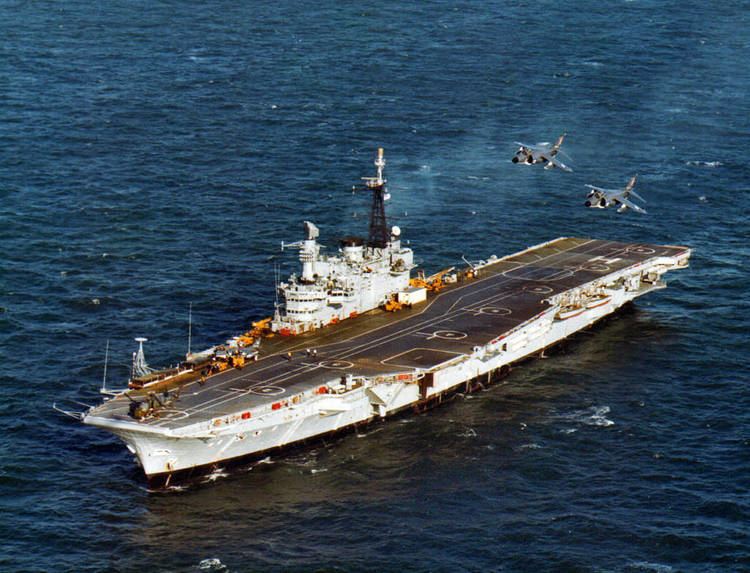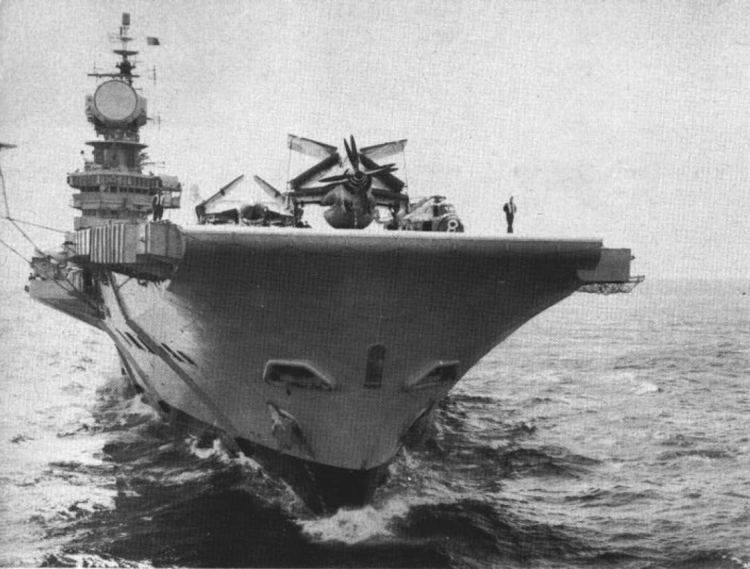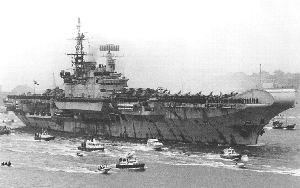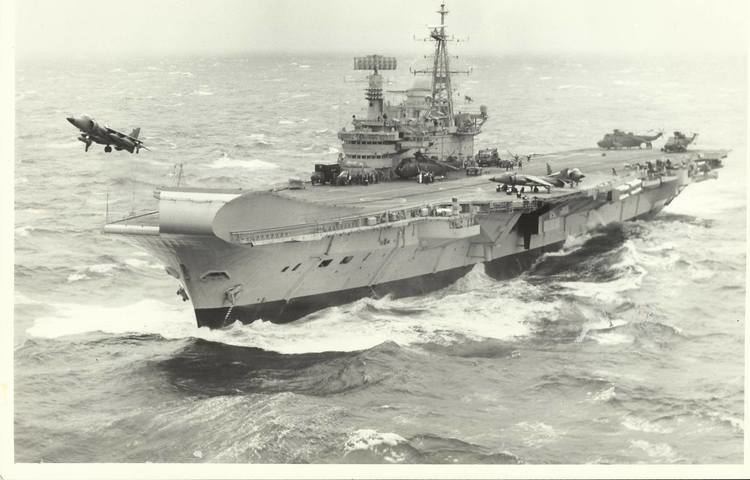Name HMS Hermes Commissioned 25 November 1959 Struck 1985 Length 236 m Launched 16 February 1953 Builder Vickers-Armstrongs | Laid down 21 June 1944 Decommissioned 1984 Construction started 21 June 1944 Draft 8.5 m | |
 | ||
HMS Hermes was a conventional British aircraft carrier and the last of the Centaur class.
Contents
- Construction and modifications
- Cost
- Proposed operation of F 4 Phantom
- Proposed transfer to Australia
- Proposed international fleet
- CommandoASWSTOVL carrier
- Falklands War
- After the Falklands War
- Viraat
- Complement
- References
Hermes was in service with the Royal Navy from 1959 until 1984, and she served as the flagship of the British forces during the 1982 Falklands War.

After being sold to India in 1986, the vessel was recommissioned and remained in service with the Indian Navy as INS Viraat until 2016.

Construction and modifications

The ship was laid down by Vickers-Armstrong at Barrow-in-Furness during World War II as HMS Elephant. Construction was suspended in 1945 but work was resumed in 1952 to clear the slipway and the hull was launched on 16 February 1953. The vessel remained unfinished until 1957, when she entered service on 18 November 1959 as HMS Hermes after extensive modifications which included installation of a massive Type 984 'searchlight' 3D radar, a fully angled deck with a deck-edge elevator, and steam catapults. With these changes she more resembled the reconstructed aircraft carrier Victorious than the other three ships in the class.

Hermes initially operated Supermarine Scimitar, de Havilland Sea Vixen, and Fairey Gannet fixed-wing aircraft, together with Westland Whirlwind helicopters.
Cost
Hermes cost £18 million, with another £1 million for electronic equipment and £10 million for aircraft in 1959.
Proposed operation of F-4 Phantom
Civil Lord of the Admiralty John Hay said in Parliament on 2 March 1964 that "Phantoms will be operated from "Hermes", "Eagle" and the new carrier when it is built. ... Our present information and advice is that the aircraft should be able to operate from "Hermes" after she has undergone her refit." This seemed optimistic, as most sources believed Victorious was the smallest carrier then in commission that the modified RN F-4K versions of the Phantom could realistically have operated from. While the Phantoms built for the RN were modified in ways similar to F-8 Crusaders for the French Navy - improving deceleration on landing - the modifications were not entirely successful. Hermes's flight deck was too short, her arresting gear as well as her catapults were not powerful enough to recover or launch the F-4K's, even though they were slightly lighter, more economical and higher performing than their US Navy counterparts. The Phantom trials held on Hermes in 1969-70 proved this out, though in the views of Minister of Defence, Denis Healey, the carrier could operate the most modern aircraft, but in too small numbers to be effective. The MOD briefly considered F-8's, and then considered the A-4M Skyhawk around 1969; the French had successfully operated the F-8 from its two Clemenceau-class light fleet carriers (which, at 869 feet (265 m) were much larger than Hermes), while the A-4 had been selected by the Royal Australian Navy to operate from HMAS Melbourne. However, both the Crusader and the Skyhawk were already considered near-obsolete by the end of the 1960s. Nevertheless, the light A-4M Skyhawks would have allowed the Hermes to carry a viable late 1970s airgroup of 20 Skyhawks, 6 Sea Kings and 4 Gannet AEW aircraft..
Proposed transfer to Australia
A 1966 review indicated that Hermes was surplus to operational requirements and she was offered to the Royal Australian Navy (RAN) as a replacement for HMAS Melbourne. In 1968, Hermes took part in a combined exercise with the RAN, during which the carrier was visited by senior RAN officers and Australian government officials, while RAN A-4G Skyhawks and Grumman S-2 Trackers practised landings on the larger carrier. The offer was turned down due to operating and manpower costs.
Proposed international fleet
Hermes served as one of four Royal Navy strike carriers mainly in the Indian Ocean and finally in the Mediterranean Sea until decommissioned in 1970. She could have seen action against the Egyptians when Egypt closed off the Straits of Tiran to Israeli shipping in May 1967 when the UK and US contemplated forming an international fleet to open the straits with force if necessary, but the idea never materialised.
The final CATOBAR air wing in 1968-1970 consisted of:
Commando/ASW/STOVL carrier
When the decision was made in the mid-1960s to phase out fixed wing carrier operations Hermes was slated to become a "Commando Carrier" for Royal Marine operations (similar in concept to a US Navy LHA). Therefore, Hermes was docked down in number 10 Dock in Devonport Dockyard between 1971 and 1973, undergoing a conversion in which her arresting cables, steam catapults, and 3-D radar were removed. Landing craft and berthing for 800 troops were added and her airwing became approximately 20 Sea King helicopters. By 1976, with the Soviet submarine threat becoming apparent and through NATO pressure, a further mild conversion was performed for Hermes to become an anti-submarine warfare carrier to patrol the North Atlantic. Hermes underwent one more conversion and new capabilities were added when she was refitted at Portsmouth from 1980 to June 1981, during which a 12-degree ski-jump and facilities for operating Sea Harriers were incorporated. After this refit the air wing comprised:
Falklands War
Hermes was due to be decommissioned in 1982 after a 1981 defence review (that would have made the Royal Navy considerably smaller) by the British government, but when the Falklands War broke out, she was made the flagship of the British forces, setting sail for the South Atlantic just three days after the Argentine invasion of the Falkland Islands. She sailed for the Falklands with an airgroup of 12 Sea Harrier FRS1 attack aircraft of the Royal Navy's Fleet Air Arm, and 18 Sea King helicopters. A few weeks after sailing, more aircraft were flown or transported via other ships to replace some losses and augment the task force. Hermes's airgroup grew to 16 Sea Harriers, 10 Hawker Siddeley Harrier GR3s of the Royal Air Force, and 10 Sea Kings (after some of the helicopters were dispersed to other ships) as well as a troop of Special Air Service (SAS) and Royal Marines. As she was the RN's largest carrier, she was considered too valuable to risk close into the Falklands, due to the possibility of Argentine air force attacks. Her Harriers therefore operated at the limit of their endurance radius, but were very successful in keeping the enemy aircraft at bay.
Air group at the height of the Falklands Conflict:
After the Falklands War
After her return home from the Falklands conflict Hermes entered into a much needed 4-month refit to her propulsion and electrical systems, as well as a thorough cleaning and repainting. When this was completed in November 1982, she embarked stores and performed work-ups exercises. She then took part in NATO exercises in the North Atlantic, and the Mediterranean Sea as a commando carrier. In the autumn of 1983 she took part in her last exercise, Ocean Safari, where she reverted to a strike carrier role, embarking 12 Sea Harriers, 10 RAF Harrier GR.3s and 10 Sea Kings. After this exercise she called into Devonport for a minor refit and thereafter into maintained reserve in Portsmouth.
In 1983, when the proposed sale of the aircraft carrier Invincible to the Royal Australian Navy was cancelled following the Falklands War, an offer was made to sell Hermes and a squadron of Sea Harriers to Australia. However the new Hawke Government decided against purchasing a replacement for HMAS Melbourne.
HMS Hermes served with the Royal Navy until 12 April 1984. On this day she entered Portsmouth with a reduced crew, under her own steam, flying the White Ensign for the final time as a seagoing ship.
Viraat
In April 1986 Hermes was towed from Portsmouth Dockyard to Devonport Dockyard to be refitted, re activated and sold to India, recommissioning and sailing as INS Viraat in 1987.
Complement
Her typical aircraft complement in the late 1960s consisted of 12 Sea Vixen FAW2s, 7 Buccaneer S2s, 4 Gannet AEW3s, 1 Gannet COD4, 5 Wessex HAS3s and 1 Wessex HAS1. She was recommissioned as a commando carrier in 1973, as an ASW carrier in 1976 (carrying around 20 or so Sea King and Wessex helicopters), and then as a V/STOL carrier in 1981. Hermes initial complement of aircraft as a V/STOL carrier was 5 Harriers and 12 Sea King helicopters, though she had the capacity for up to a total of 37 aircraft.
